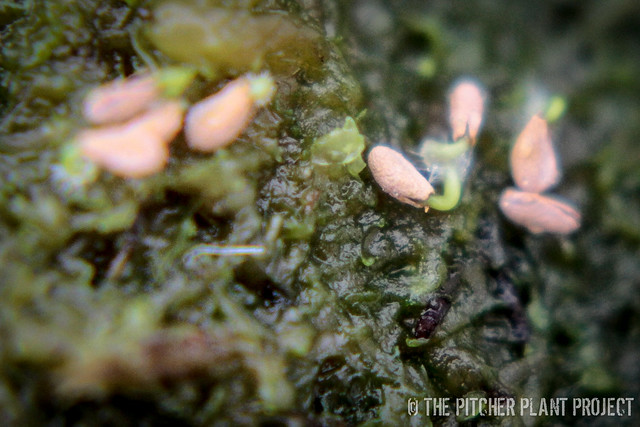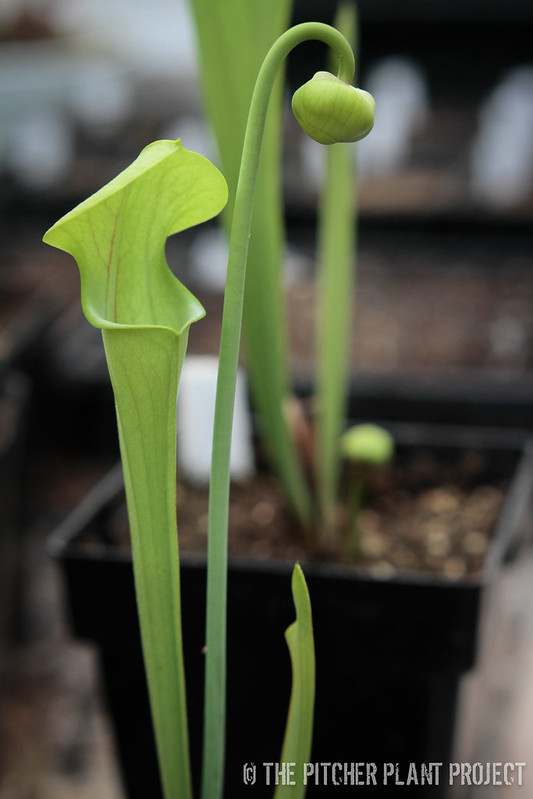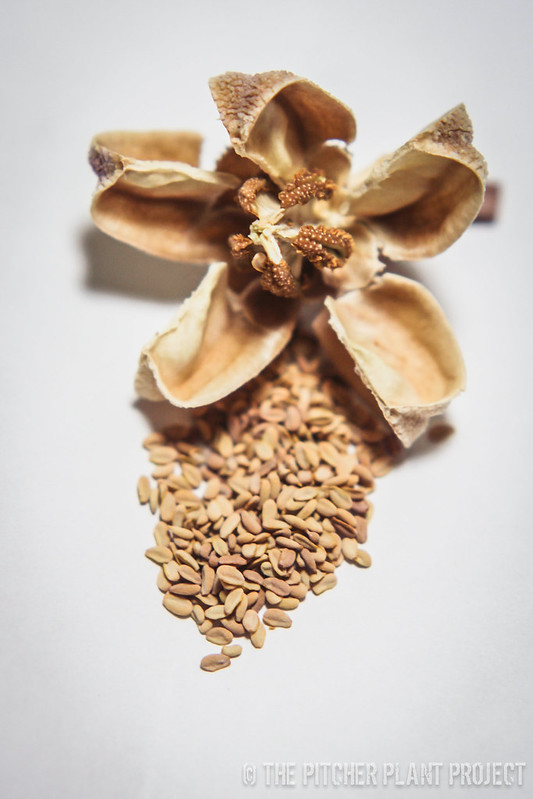February, so far, is looking pretty fab. Thanks to the warm January, much of the crop has been moving at a very fast speed. There are plenty of buds to be found all over the place, a few open pitchers, and… seeds germinating! Enjoy a few snapshots from the past couple of weeks.
***
 The seeds (from 2013!!) have been sown! Yes, you read that right. These have been sitting in cold stratification for a year. A couple of weeks ago, my wife and the kiddos helped pot up all 202+ crosses. It was an extremely busy year for me last year and by the time I was ready to put them down, the year was half way over. I didn’t want to use supplemental lighting as with this many seeds, as that electric bill would just be nuts. Now that I finally have a little more space, I was able to finally put these down.
The seeds (from 2013!!) have been sown! Yes, you read that right. These have been sitting in cold stratification for a year. A couple of weeks ago, my wife and the kiddos helped pot up all 202+ crosses. It was an extremely busy year for me last year and by the time I was ready to put them down, the year was half way over. I didn’t want to use supplemental lighting as with this many seeds, as that electric bill would just be nuts. Now that I finally have a little more space, I was able to finally put these down.
 And guess what? Many pots have seeds that have are sprouting! Exciting! The one in the photo is S. purpurea heterophylla x leucophylla “Red” – these came from Jerry Addington and should produce a brilliant crop of anthocyanin free recessive plants to work with in the future.
And guess what? Many pots have seeds that have are sprouting! Exciting! The one in the photo is S. purpurea heterophylla x leucophylla “Red” – these came from Jerry Addington and should produce a brilliant crop of anthocyanin free recessive plants to work with in the future.
 The Asylum. Check out the Sarracenia alata flowers already opening up! And check out that other half of the greenhouse that needs trimming! Heh!
The Asylum. Check out the Sarracenia alata flowers already opening up! And check out that other half of the greenhouse that needs trimming! Heh!
 Sarracenia rosea – Baldwin Co., AL in flower.
Sarracenia rosea – Baldwin Co., AL in flower.
 A few more Sarracenia alata buds about to pop!
A few more Sarracenia alata buds about to pop!
 One of my crosses from a maybe 3 or so years ago. This is S. ‘Alucard’ x ‘Adrian Slack’ glowing with the sun hitting it from behind. Notice one of last year’s autumn pitchers compared to this year’s larger spring pitcher. What a jump! You can see tell-tale signs of what the plant would be like from last year’s pitcher. However, with this year’s pitcher, you can see much more character shine through! The unknown of what comes out of the cross and how that plant matures is part of the excitement that comes with growing from seed. Anyway, I’ll post another photo later on so you can get a better view of this year’s most recent pitcher from this cross.
One of my crosses from a maybe 3 or so years ago. This is S. ‘Alucard’ x ‘Adrian Slack’ glowing with the sun hitting it from behind. Notice one of last year’s autumn pitchers compared to this year’s larger spring pitcher. What a jump! You can see tell-tale signs of what the plant would be like from last year’s pitcher. However, with this year’s pitcher, you can see much more character shine through! The unknown of what comes out of the cross and how that plant matures is part of the excitement that comes with growing from seed. Anyway, I’ll post another photo later on so you can get a better view of this year’s most recent pitcher from this cross.
 Sarracenia ‘Reptilian Rose’ x (flava var. rubricorpora x leucophylla) – Clone 14. New pitcher coloring up against last year’s wreckage. Cross by Dr. Travis H. Wyman.
Sarracenia ‘Reptilian Rose’ x (flava var. rubricorpora x leucophylla) – Clone 14. New pitcher coloring up against last year’s wreckage. Cross by Dr. Travis H. Wyman.
 Sarracenia ‘Reptilian Rose’ x (flava var. rubricorpora x leucophylla) – Clone 9
Sarracenia ‘Reptilian Rose’ x (flava var. rubricorpora x leucophylla) – Clone 9
Cross by Dr. Travis H. Wyman
 Another one of my crosses – Sarracenia leucophylla “Purple Lips” x flava var. rubricorpora x ‘Adrian Slack’ – new pitcher opening up!
Another one of my crosses – Sarracenia leucophylla “Purple Lips” x flava var. rubricorpora x ‘Adrian Slack’ – new pitcher opening up!
 Sarracenia oreophila, awake and ready to devour insects!
Sarracenia oreophila, awake and ready to devour insects!
 Sarracenia alata – Anthocyanin Free!
Sarracenia alata – Anthocyanin Free!
A new pitcher stands out against last year’s crispy dead pitchers.
 Young pitchers stretch towards the sky. Sarracenia flava var. rubricorpora x flava ‘Suspicion’ – an anthocyanin free recessive cross. This cross was done by Aidan Selwyn. I hope to use these AF recessive S. flava plants in future (anthocyanin free) crosses.
Young pitchers stretch towards the sky. Sarracenia flava var. rubricorpora x flava ‘Suspicion’ – an anthocyanin free recessive cross. This cross was done by Aidan Selwyn. I hope to use these AF recessive S. flava plants in future (anthocyanin free) crosses.
 Ok, ok, ok… I’m totally geeking out here. This is a flower bud of an anthocyanin free form of S. flava – Colquitt Co., GA. YEAH. You know what this means… 🙂
Ok, ok, ok… I’m totally geeking out here. This is a flower bud of an anthocyanin free form of S. flava – Colquitt Co., GA. YEAH. You know what this means… 🙂


 Sarracenia oreophila
Sarracenia oreophila



 End of an era.
End of an era.

 Cramped.
Cramped. There are tiny beasts locked up in the shells.
There are tiny beasts locked up in the shells.















